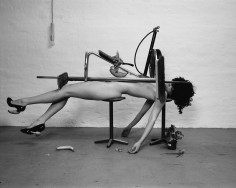Melanie Bonajo
梅拉妮·柏娜桥
Furniture Bondage
Furniture 17
source: pristinaorg
Melanie Bonajo usa de fotografias, videos, performances e instalações para examinar o progresso e como a tecnologia avança e, ao mesmo tempo, aliena o indivíduo.
Suas obras exploram o vazio espiritual de uma geração e a mudança de relacionamento entre as pessoas e a natureza.
.
.
.
.
.
.
.
source: willemaertsnl
Melanie Bonajo is geboren in Heerlen, 1978. Ze volgde haar opleiding aan de Gerrit Rietveld academie waar ze in 2002 afstudeerde. Hoewel Melanie Bonajo op de eerste plaats een fotograaf is, werkt ze als een performance artiest. Inmiddels heeft ze en indrukwekkende CV van zowel Nederlandse als internationale exposities. Haar werk verschijnt regelmatig in boekvorm of als uitgebreide museum catalogus, maar ook in tijdschriften als Capricious, Glumagazine en Zoo.
Vanuit een technisch perspectief zijn haar foto’s vaak ingenieuze constructies. Aan de andere kant kan het haar vaak niet schelen of een foto technisch perfect is, het juiste licht of de juiste compositie heeft. Dan registreert ze simpelweg wat er te zien is of wat ze heeft gebouwd. Haar werk bevat elementen van performance en installatiekunst, net als het werk van haar Nederlandse collega’s die in dezelfde tijd als haar aan de Gerrit Rietveld Academie studeerden..
.
.
.
.
.
.
source: fitnycedu
Possessions, however desired or useful, can become a burden over time. Yet, they also become a very real part of who we are and the lives we build for ourselves. Melanie Bonajo explores our relationships with material objects and the role they play in our creation of ‘self.’ The series Furniture Bondage speaks to the need for a perfect harmony with the world around us. The result is a new living form, a fusion of the human body with its external trappings.
Melanie Bonajo was born in Heerlen, Netherlands, and studied photography and fine arts at the Gerrit Rietveld Academy in Amsterdam. Her photographs have been exhibited at the SMBA/ Stedelijk Museum and Galerie Fons Welters in Amsterdam, and at numerous other international galleries and institutions. Bonajo is represented by PPOW Gallery in New York. She divides her time between Amsterdam and Berlin.
.
.
.
.
.
.
source: featureshoot
Melanie Bonajo lives and works in The Netherlands. Her furniture bondage photographs from the project “All Cliches Are True” explore material objects and the role they play in society. About her work, Melanie says,”The furniture bondage series speaks of the impossible need to create a perfect harmony with the world around us by exploring seemingly opposing elements together: a choreography of magnetic fields lingering between attachment/detachment, bonded/liberated, subject/object.” Melanie has had several solo shows including “As Thrown Down From Heaven” at the PPOW Gallery in New York and “Modern Life of the Soul” at the Fette Gallery in Los Angeles.
.
.
.
.
.
.
.
source: rencontres-arles
Mélanie Bonajo est l’une des figures les plus importantes de la Nouvelle Vague de la photographie hollandaise. Son oeuvre la plus connue reste sans doute sa série Furniture Bondage (« Bondage mobilier »), qui représente des femmes nues attachées à des meubles.
Mais Bonajo n’est pas cantonnée à un seul médium. Au fil des années, elle n’a jamais cessé de nous surprendre en exprimant ses idées de toutes sortes de manière. En ce moment par exemple, Bonajo se produit avec son groupe ZaZaZoZo.
Le thème principal qui traverse toute son oeuvre, quel que soit le médium choisi, est le corps féminin et la manière dont il se définit lui-même. Dans cette exposition, elle partage avec le public des photographies où elle se documente elle-même au fil du temps. Alors qu’elle était prise dans les tourments d’une relation amoureuse, elle a décidé de se prendre en photo en train de pleurer. Par la suite, à chaque fois qu’elle sentait les larmes lui monter aux yeux, elle attrapait son appareil photo et capturait une image d’elle-même en guise de thérapie. En prenant la rupture – ou plutôt sa rupture – comme sujet, elle touche ainsi aux thèmes universaux du deuil et de la souffrance quotidienne.
Erik Kessels


